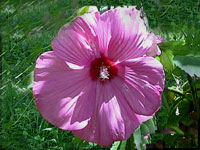
We have one hibiscus growing in Explore the Wild (ETW). You may have seen it. When it blooms the flowers are very large, about 6-8 inches across, and are pink or magenta in color. If you’ve walked by the vending area in ETW during the last few weeks you would have noticed the flowers (the plant has since gone by, it’s no longer blooming).
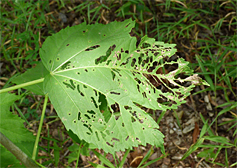
But this is not about the flowers, this is about the leaves and what’s eating them. Though, as far as mysteries go, this is not a very difficult one to solve. One need only to turn over a leaf to see who the culprit is, a small caterpillar, or is it? Is the little green insect munching down on the leaves a caterpillar or something entirely different?
“Well, what else would it be Ranger Greg,” you say, “caterpillars eat leaves, don’t they?”
Well, yeah, that’s what I thought too the first time I saw one of these little green worms, “it’s a caterpillar.”
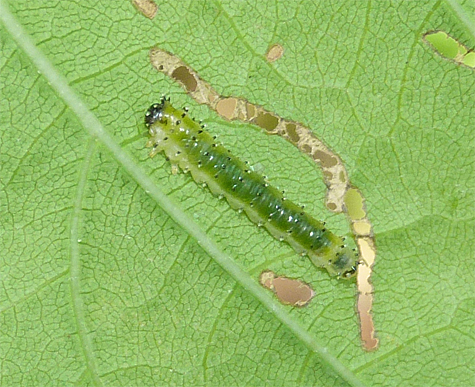
But I looked a bit closer at both the plant and the larva. Right away I found references to a particular sawfly that specializes in hibiscus, mallow, hollyhocks and Rose of Sharon.
Now I needed to take a closer at the larva. Caterpillars, the larvae of moths or butterflies, have 2 – 5 pairs of prolegs on their abdomens, sawflies have 6 or more. What’s a proleg? Prolegs are legs on the larvae of some insects (butterflies, moths, sawflies, and some flies) which are not segmented as true legs are and which are absorbed into the body when the insect morphs into adulthood. The true legs on a caterpillar or other larva are located on the thorax (up near the front). Imagine these long-bodied insects trying to get around with only the front legs. Their rear ends would simply drag or flop around behind them.
Unfortunately I didn’t have the forethought to actually photograph the prolegs on the larva in question, but I counted them, there were six. And since I didn’t photograph them I can’t show you what they look like or where they’re located. I do, however have a photo of a caterpillar showing its 5 pair of prolegs, as well as its 3 pair of “real” legs (Remember, insects have 6 legs or 3 pair of legs).
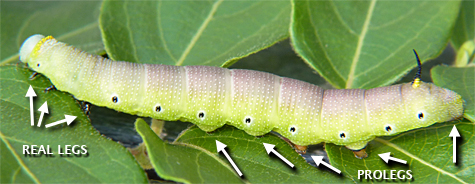
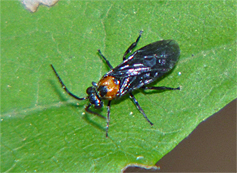
The adults which are much smaller than the larvae (by about half) and look quite a bit different than what might be expected, considering that the larva looks like a caterpillar. The adults look more like bees or wasps than they do butterflies or moths. That’s because they’re in the same order as wasps, Hymenoptera. Butterflies are in the Lepidoptera order of insects.
So, the next time you happen upon a hibiscus plant and notice that the leaves are full of holes, take a closer look at them, you might find a sawfly larva, or two, feeding on the leaf (there are usually more than one). You may even see one of the adults.
Enjoy!
I’m in Oregon with a green worm problem. They are burrowed into my almost to bloom hibiscus which are an exotic type. We have had an extemely hot spring and summer never known problem on these plants. Do we have sawflies in Oregon. I’m used to dealing with mildew problems.
I’d rather deal with sawflies than mildew, but it seems you have both. Yes, there are sawflies in Oregon.
Thanks, and good luck.
So, what is the best way to get rid of this hibiscus pest?
I would manually remove the larvae from the plant.
Thanks,
I have an American Hibiscus (the perennial that dies down every fall and then comes back every year, growing six fee tall and bearing very large white with pink center flowers.
Something is eating the leaves, leaving large holes.
I saw a metallic green beetle on one leaf today, caught it and threw it away – was that the culprit, or is it likely something else?
Green metallic beetle? Any bronze in that metallic coloration? If so, I’d say it was a Japanese beetle.
can’t send a pic, but with further research I think it might be a sawfly??
If you can see the larvae, remove them from the plant. Otherwise use a horticultural soap or oil. There are recipes for those on the web.
Try to control for next year by cultivating the soil beneath the plant where the larvae pupate during the winter. Cultivating the soil may expose the pupae to cold temps where they may not survive.
Thanks,
I have seen quite a few of the worms , both on top and under the leaf, also have seen a bright green worm inside the flower in which the bud is yellow. What can I use to get rid of them without killing all the other flowers. There are at least 100 buds on the plant, and don’t want to hurt these. Is there something organic to use so I don’t harm the bees and the enviroment? Thanking you in advance!!! HELP!!!!!!
I found a brown caterpillar, which lookes at first like a dead leaf. One end stood up and there were two clawlike bits at the back. what is it?
Can you send a photo of the insect?